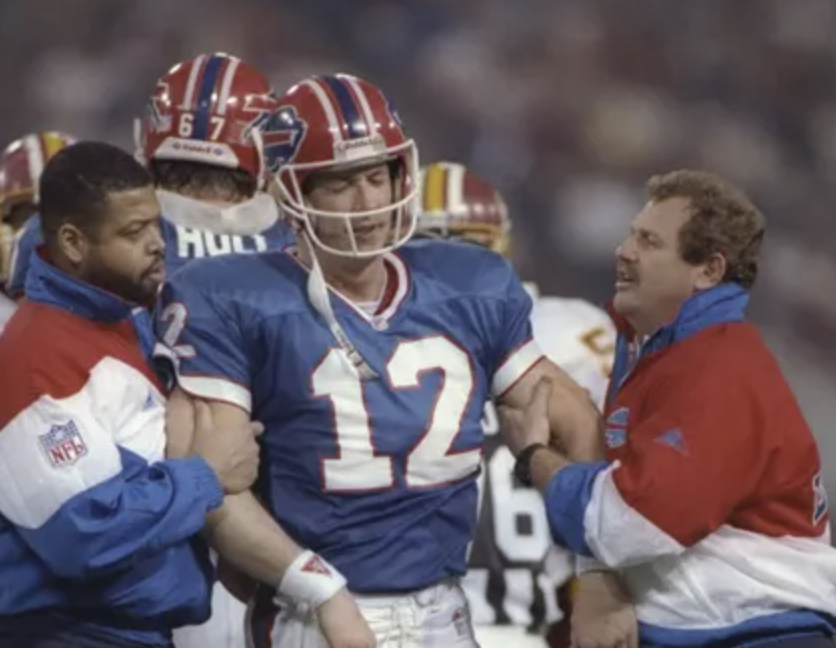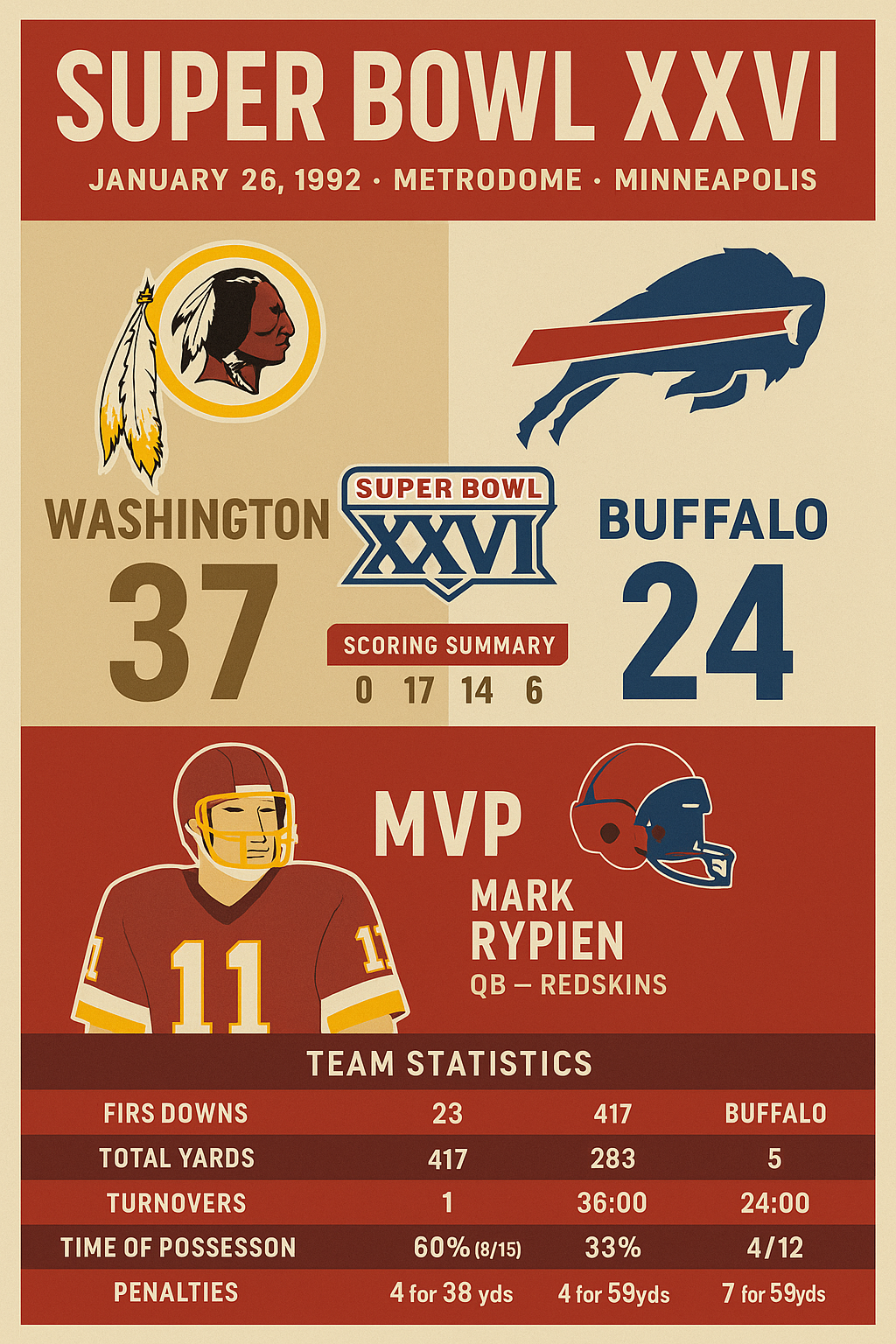Super Bowl XXVI: Washington’s Commanding Statement

On January 26, 1992, at the Metrodome in Minneapolis, Minnesota, the Washington Redskins delivered a performance that was as dominant as it was deliberate. Super Bowl XXVI, the NFL’s championship game for the 1991 season, saw Washington overwhelm the Buffalo Bills by a score of 37–24, in a game that was never as close as the final tally might suggest.
The victory marked Washington’s third Super Bowl title in a decade, cementing head coach Joe Gibbs’ legacy and showcasing the strength of a team that is often overlooked in conversations about all-time greats.
As the Bills dropped their second straight Super Bowl, the narrative was one of two franchises going in different emotional directions—one at the peak of its powers, and the other wrestling with the burdens of unfulfilled expectations.
Setting the Stage: Dynasty vs. Destiny
The 1991 Washington team was a juggernaut. They finished the regular season 14–2, outscoring opponents by more than 260 points and winning games with surgical precision. Under Joe Gibbs—already a two-time Super Bowl champion—the team featured an offense built around MVP quarterback Mark Rypien, future Hall of Fame receiver Art Monk, and a punishing offensive line nicknamed “The Hogs.”
Defensively, they were just as dangerous. Anchored by linebacker Wilber Marshall, cornerback Darrell Green, and a cohesive pass rush, Washington ranked second in the league in fewest points allowed.
The Buffalo Bills, meanwhile, were making their second consecutive Super Bowl appearance under head coach Marv Levy. Their “K-Gun” no-huddle offense, featuring Jim Kelly, Thurman Thomas, Andre Reed, and James Lofton, had crushed opponents with pace and explosiveness all year.
But in Minneapolis, that weaponized offense would be neutralized—methodically, forcefully, and, at times, embarrassingly.
“Washington didn’t just beat Buffalo. They disassembled them,” said Sandra Valente, senior archivist at the Super Bowl Historical Society. “It was one of the most complete team victories ever put on display in a Super Bowl.”
The First Half: A Blueprint of Domination
From the opening kickoff, Washington set the tone. Their first few drives didn’t result in points, but the tempo was unmistakably in their control. On the other side, Buffalo’s offense sputtered early—failing to register a first down on its first four possessions.
In the second quarter, the floodgates opened.
A 10-play, 89-yard drive capped by a 10-yard touchdown pass from Rypien to Earnest Byner made it 7–0. On the ensuing possession, Jim Kelly threw an interception that was returned to the 2-yard line, leading to a Gerald Riggs touchdown. After another quick three-and-out, Washington added a 34-yard field goal before halftime.
It was 17–0 at the break—and Buffalo looked shell-shocked.
Rypien’s Career Performance
Much like Doug Williams four years earlier in Super Bowl XXII, Mark Rypien used the biggest stage in football to deliver the performance of his life.
The 6’4” quarterback threw for 292 yards and two touchdowns, including a 30-yard bomb to Gary Clark in the third quarter that stretched the lead to 24–0. Rypien made every throw look effortless and avoided the costly turnovers that plagued Kelly.
“Rypien wasn’t flashy, but he was fearless,” noted Dr. Harold Miner, NFL historian with the Super Bowl Historical Society. “He didn’t just manage the game—he conquered it.”
Rypien was named Super Bowl MVP, the first Canadian-born player to earn the honor.
Buffalo’s Second-Half Rally: Too Little, Too Late
To their credit, the Bills didn’t fold. In the second half, they scored three touchdowns—two on Jim Kelly passes and one late-game rushing TD by Kenneth Davis. But every time Buffalo inched closer, Washington responded. A key interception return by Brad Edwards (one of two picks on the day) and another short TD run by Gerald Riggs sealed the deal.
Jim Kelly finished with 275 passing yards, two touchdowns, and four interceptions—a brutal stat line for a Hall of Fame quarterback. Thurman Thomas, who famously missed the first two plays because he lost his helmet, had only 13 rushing yards on 10 carries—a massive drop-off from his usual production.
The Bills simply couldn’t recover from their early hole, and Washington never gave them room to breathe.
Final Score:
- Washington Redskins: 37
- Buffalo Bills: 24
The game wasn’t nearly as close as the score suggests. Washington led 37–10 with just over six minutes left before the Bills tacked on two late touchdowns.

Super Bowl XXVI by the Numbers
| Stat Category | Washington | Buffalo |
|---|---|---|
| First Downs | 23 | 19 |
| Total Yards | 417 | 283 |
| Turnovers | 1 | 5 |
| Time of Possession | 36:00 | 24:00 |
| Third Down % | 60% (9/15) | 33% (4/12) |
| Penalties | 4 for 38 yds | 7 for 59 yds |
Washington’s ability to dominate both time of possession and turnover margin tells the story. They played clean, efficient, balanced football.
Key Players
- Mark Rypien – MVP, 18-of-33, 292 yards, 2 TDs
- Gary Clark – 7 catches, 114 yards, 1 TD
- Art Monk – 7 catches, 113 yards
- Brad Edwards – 2 INTs, 1 long return
- Gerald Riggs – 2 rushing TDs on short-yardage attempts
- Darrell Green – key coverage and open-field tackles
Buffalo’s statistical leaders, like Kelly and Reed, racked up yards in garbage time—but the damage had long been done.
Joe Gibbs’ Legacy
Super Bowl XXVI made Joe Gibbs one of only two head coaches (at the time) to win three Super Bowls with three different quarterbacks—Joe Theismann (XVII), Doug Williams (XXII), and Mark Rypien (XXVI).
It’s a feat unmatched in terms of adaptability. Gibbs didn’t rely on one system or superstar. He built teams, not just schemes.
He remains a revered figure in NFL history—not just for the wins, but for how he got them.
Buffalo’s Continued Heartbreak
The Bills were now 0–2 in Super Bowls, and worse, had been blown out in one after a heartbreaking loss in another. Questions began to swirl: Could the K-Gun win the big one? Was Kelly’s playoff record a problem? Could Levy adjust when Plan A failed?
The answers weren’t yet clear. What was clear was that Washington had exposed Buffalo’s weaknesses—and those same cracks would haunt them in future title games.
Still, the Bills deserve credit for resilience. They’d return to the Super Bowl twice more (XXVII, XXVIII), becoming the only team to reach four consecutive Super Bowls, even if all ended in losses.
Broadcast and Culture
CBS aired the game, with Pat Summerall and John Madden calling the action. The broadcast drew over 79 million viewers, and the halftime show, themed “Winter Magic,” starred Gloria Estefan and Olympic figure skaters Brian Boitano and Dorothy Hamill.
The 1991 season was marked by significant cultural shifts—post-Gulf War America, the rise of cable sports media, and the beginning of the free agency era in the NFL. Super Bowl XXVI sat right at the center of that evolution.
Legacy of Super Bowl XXVI
Today, Super Bowl XXVI is often overshadowed by the drama of its immediate predecessors and successors. But for true football purists, it's a masterclass in execution. It’s a blueprint of what happens when talent, discipline, and coaching all align.
“This Washington team should be in the GOAT conversation,” Sandra Valente concluded. “They beat great teams and looked nearly invincible doing it. What more do you want?”
It was the peak of an era for Washington—and the beginning of one of the most fascinating runs of disappointment for Buffalo.
One team raised the Lombardi Trophy. The other carried the weight of history.